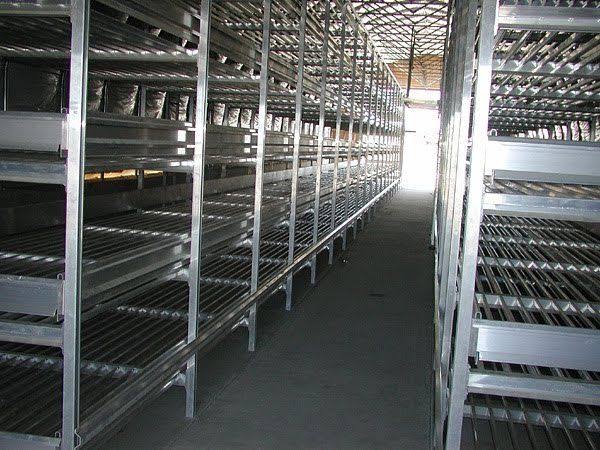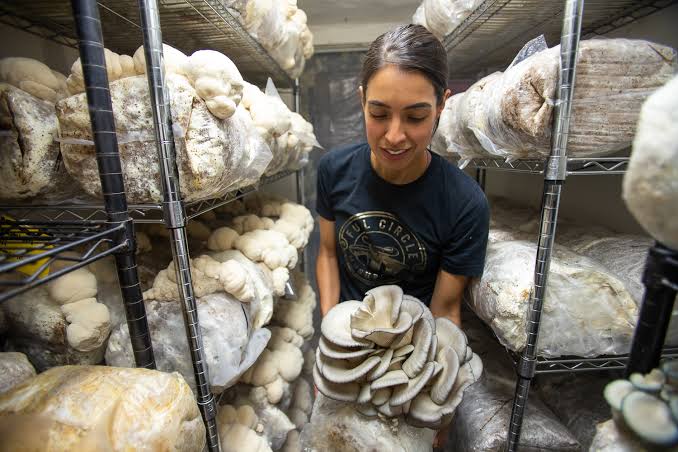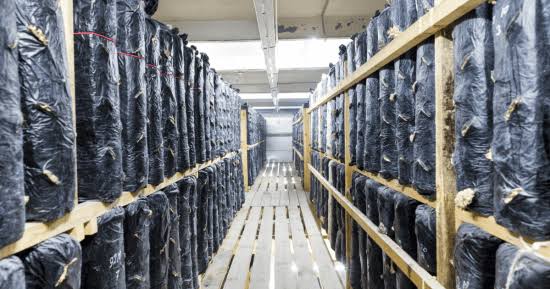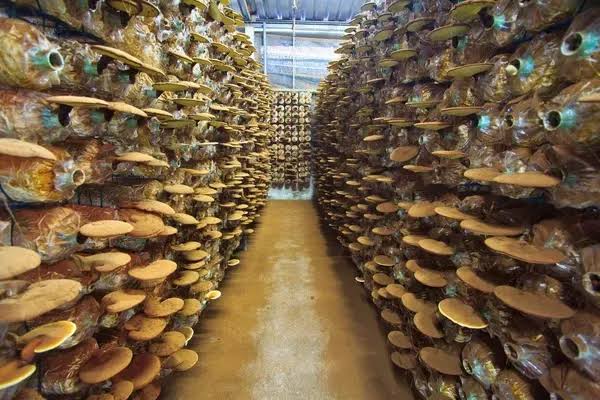Building a mushroom growing house is a rewarding venture for anyone interested in sustainable farming, whether on a small or large scale. Creating an optimal environment for mushroom growth involves careful planning and attention to detail, as mushrooms have unique requirements for temperature, humidity, and airflow.
The housing structure becomes a critical aspect of success, offering control over these factors to facilitate productive cultivation. To begin, it is essential to understand not only the specific environmental needs of mushrooms but also the materials required for mushroom cultivation and the key aspects that go into designing a functional and efficient mushroom cultivation house.
When designing a mushroom growing house, the primary goal is to create a space that promotes consistent growth and high yield. Unlike most plants, mushrooms are fungi and thrive in low-light environments, making indoor structures ideal for their cultivation.
The initial step in building a mushroom house is to consider the types of mushrooms you wish to grow, as different varieties have specific temperature and humidity needs.
Oyster mushrooms, for example, prefer temperatures between 20-30°C, while shiitake mushrooms flourish in cooler conditions. Having clarity on the variety allows you to choose materials and a design layout that best supports the mushrooms’ needs.
The materials required for mushroom cultivation will vary depending on factors such as location, budget, and scale. A well-designed mushroom house typically includes materials that offer insulation and temperature control.
Insulation materials like Styrofoam, plastic sheeting, and wood are common choices, as they help maintain a consistent internal climate. If the mushroom house is located in a warmer climate, additional ventilation may be necessary to prevent overheating, while in colder areas, added insulation or heating equipment might be needed to keep the environment within the preferred range.
Humidity control is equally crucial, and materials that resist moisture, like PVC piping for irrigation, are beneficial. A reliable misting or humidity system will ensure that the mushrooms receive the moisture they need without excessive watering, which could lead to mold or contamination.
Mushroom housing design is another key aspect to consider, as the layout directly impacts both ease of access and the health of the crop. A typical mushroom house design will often include tiered shelving to maximize space efficiency, allowing growers to cultivate multiple rows or layers of mushrooms in a relatively small area.
Using vertical space through shelves or racks is practical for small-scale setups and can be scaled up for larger operations. Adjustable shelving also allows for flexibility when changing mushroom varieties, as you can alter the distance between shelves to accommodate the size and growth pattern of different mushrooms.
Proper airflow is also critical in a mushroom cultivation house to prevent stagnation and reduce the risk of contamination. Fresh air exchange is essential because mushrooms release carbon dioxide as they grow, which can inhibit growth if it builds up. Including ventilation points in the design helps maintain airflow, while fans or exhaust systems can further enhance circulation.
Some growers install humidifiers or misting systems to keep the air moisture-rich, especially in drier climates where maintaining high humidity can be a challenge. The balance between fresh air and humidity is delicate, as too much airflow can dry out the mushrooms, while insufficient ventilation can foster mold growth.
Mushroom housing must be designed with hygiene in mind, as contamination is a major concern in mushroom cultivation. Building a mushroom house with easy-to-clean surfaces is essential, as it reduces the likelihood of mold, pests, or diseases affecting the crop. Using non-porous materials for floors and walls, such as concrete or sealed wood, helps make cleaning easier.
The mushroom cultivation house should also be equipped with a water drainage system to prevent standing water, which can be a breeding ground for contaminants. Regular sanitation of the entire growing area, including shelving and tools, further helps maintain a clean environment that supports healthy mushroom growth.
Light management is another vital consideration in the mushroom house design. Since mushrooms don’t rely on sunlight for energy as plants do, they can be cultivated in low-light environments. However, certain varieties of mushrooms benefit from some exposure to indirect light, which influences their growth and development.
Small windows, diffused artificial lighting, or a simple opening for filtered sunlight can provide the right amount of light, but direct sunlight should be avoided as it can increase temperatures and dry out the environment.
Balancing light levels also helps support worker visibility and safety within the mushroom house without compromising the conditions needed for optimal mushroom development. For those who intend to scale up, the design of a mushroom house can incorporate automation to monitor and control environmental factors.
Automated systems for temperature, humidity, and airflow can simplify the cultivation process, especially in larger setups where manual adjustments can become labor-intensive. Many modern mushroom growers rely on sensor-based systems that track changes in the environment and automatically adjust conditions to stay within ideal ranges.
Although this setup requires a higher initial investment, it significantly enhances efficiency and can lead to better yield and quality over time. Building a mushroom cultivation house also requires planning for the initial stages of growth, which often involve creating a space for the inoculation and incubation processes.
During inoculation, mushroom spores or spawn are introduced to the substrate—often made from materials like straw, wood chips, or compost. This substrate is then transferred to the growing space in the mushroom housing.
Some growers set up separate incubation areas to allow the mycelium, or fungal network, to fully colonize the substrate before moving it to the primary growing area. By separating these stages, growers can optimize conditions specific to each phase of growth, ensuring stronger and more productive mushrooms.
The process of setting up a mushroom growing house might seem complex, but once operational, it provides a controlled environment that enhances mushroom yield and quality. The choice of materials, the layout of the growing space, and the inclusion of systems to control temperature, humidity, and airflow all contribute to a successful setup.
The mushroom cultivation house serves not only as a growing space but as a managed ecosystem that accommodates the specific needs of mushrooms, ensuring they flourish throughout their growth stages.
Read Also: Breeds of Sheep: Characteristics, Uses, and Benefits
Materials and Tools Required for Your Mushroom Growing House

Setting up a mushroom growing house can be an exciting venture, offering both small-scale and commercial growers a way to produce mushrooms in an environment specifically crafted for high yield and quality.
Whether you are a beginner or an experienced cultivator, building a mushroom growing house requires careful selection of materials and tools to create optimal conditions for growth.
The right setup ensures you can manage essential factors like temperature, humidity, airflow, and cleanliness—all of which play a vital role in healthy mushroom production. Below are the essential materials and tools required to build a successful mushroom growing house.
1. Insulation Materials: Insulation is vital in any mushroom growing house, as it helps maintain consistent internal temperatures, which are critical for mushroom development. Options like Styrofoam, foam board, or fiberglass insulation can help regulate warmth in cooler climates or keep excessive heat out during warmer seasons. Insulation allows the mushroom growing house to stay stable, ensuring the mushrooms receive the ideal environment for growth.
2. Plastic Sheeting: Covering the walls and floor of your mushroom growing house with plastic sheeting is an effective way to manage moisture and prevent contamination.
High humidity is essential for mushroom cultivation, and plastic sheeting helps keep moisture levels consistent while preventing outside contaminants from affecting the mushrooms. Additionally, plastic sheeting is easy to clean, helping maintain a sanitary environment within the mushroom growing house.
3. Wood or Metal Shelving: Shelving is crucial in a mushroom growing house, as it maximizes space by allowing vertical arrangement of grow bags or trays. Wooden shelves are often affordable and practical, while metal shelving is more resistant to moisture and easier to clean. Select shelving strong enough to support the weight of your growing containers and spaced appropriately to promote airflow around the mushrooms.
4. PVC Pipes and Misting System: Proper humidity levels are essential for any mushroom growing house. Using PVC pipes to create a misting system is common, as these pipes are durable and can handle moisture well.
Attach misters or nozzles to the pipes, connect them to a water source, and install them throughout the mushroom growing house. Automated misting systems ensure consistent humidity levels, preventing the need for constant manual adjustments.
5. Humidity and Temperature Control Devices: Keeping an eye on the humidity and temperature within a mushroom growing house is crucial. Humidity meters and thermometers help you track these variables, enabling you to make adjustments as needed. Automated systems are beneficial for larger setups, allowing you to maintain ideal conditions without constantly monitoring the environment yourself.
6. Fans and Ventilation Equipment: Air circulation is another essential element in a mushroom growing house, as stagnant air can lead to carbon dioxide build-up, affecting growth.
Small fans or exhaust fans help maintain steady airflow, preventing issues like mold and promoting a fresh oxygen supply. However, it’s important to regulate airflow to avoid drying out the mushrooms while still allowing for consistent air exchange.
7. Grow Bags or Trays: Most mushrooms are cultivated in bags or trays filled with a nutrient-rich substrate, such as straw, sawdust, or compost. Grow bags are commonly used in mushroom growing houses because they are convenient, minimize contamination risks, and can be discarded after each harvest. Trays are reusable but require thorough cleaning to ensure a sterile environment.
8. Spray Bottles: For smaller setups or specific mushroom varieties, spray bottles are effective for manually misting the mushrooms. A spray bottle allows for targeted humidity control in areas of the mushroom growing house that may need additional moisture, complementing larger misting systems.
9. Heaters or Cooling Equipment: Temperature control is crucial in a mushroom growing house. Depending on the mushroom variety and local climate, you may need portable heaters to keep the house warm in winter or portable coolers to reduce heat in summer. Select equipment that suits the temperature range required by your mushroom type, as too much variation can negatively affect growth.
10. Water Source and Filtration: A steady water source is essential in any mushroom growing house, as mushrooms need frequent misting and moisture. Tap water can be used, but chlorine and other chemicals may harm the mushrooms. Consider using filtered or purified water, especially if your tap water has high chlorine levels, to create a safe hydration system.
11. Lighting Fixtures (Optional): While mushrooms don’t need sunlight, indirect or low-level lighting is sometimes beneficial for certain varieties, promoting growth during particular stages. Simple LED or fluorescent lights can offer gentle, indirect lighting in a mushroom growing house without overheating or drying out the mushrooms.
12. Thermal Reflective Materials: Thermal reflective materials, such as Mylar, can help control temperature in a mushroom growing house. By reflecting warmth back into the space, these materials help maintain a stable climate. They are particularly useful in cold regions where consistent temperatures are harder to achieve without expensive heating systems.
13. Sterilization and Cleaning Supplies: Cleanliness is crucial in any mushroom growing house. Bleach, hydrogen peroxide, and alcohol are common cleaning agents that help eliminate contaminants. Keeping surfaces, tools, and equipment sanitized reduces the risk of contamination, while wearing disposable gloves and masks further protects the mushrooms from harmful pathogens.
14. Shovels, Buckets, and Mixing Containers: Tools like shovels and buckets are necessary for handling bulk substrate, while large mixing containers make it easier to combine materials such as straw, sawdust, and compost. Ensuring that these tools are disinfected before use is important to prevent contamination in the mushroom growing house.
15. Drip Trays or Drainage System: Excess water can be problematic in a mushroom growing house. Drip trays placed under grow bags or trays collect any water runoff, keeping the area free from standing water, which could attract mold. For larger operations, installing a drainage system helps direct excess water away from the mushrooms, reducing the risk of moisture-related problems.
16. pH Testing Kit: Mushrooms require a specific pH level in the substrate to grow optimally. A pH testing kit allows you to regularly check and adjust the pH level of the substrate to fit the needs of your mushrooms. Adjustments can be made with simple additives, like lime, to achieve the right acidity.
17. Scales and Measuring Cups: Accurate measurements are essential when preparing substrate mixtures for the mushroom growing house. Scales and measuring cups ensure you add the correct amounts of substrate ingredients, which prevents imbalances in nutrients or moisture that could affect mushroom development.
18. Plastic Bins or Sterilizers: Substrate sterilization is crucial in preventing mold or contamination within a mushroom growing house. Plastic bins can be used for chemical or steam sterilization, while larger setups may require dedicated sterilization equipment to ensure all materials are clean before entering the mushroom growing house.
19. Protective Clothing: In a mushroom growing house, wearing protective clothing like gloves, aprons, and masks minimizes the chance of introducing contaminants from outside. Protective gear also makes cleaning and handling mushrooms safer and prevents dirt, spores, or germs from affecting the crop.
Read Also: Different Breeds of Cattle Characteristics
Step-by-Step Instructions for Building Your Mushroom Growing House

Creating a successful mushroom growing house involves carefully selecting materials, setting up the ideal environment, and following proper steps to ensure the conditions are just right for mushroom growth. From choosing the best location to designing the layout, setting up humidity, and maintaining cleanliness, each step plays a vital role in achieving a thriving mushroom harvest.
1. Choosing the Location for Your Mushroom Growing House: The first step in building your mushroom growing house is selecting the right location. The spot should ideally be shaded and away from direct sunlight, as mushrooms thrive in cool, moist, and low-light conditions.
A basement, garage, shed, or unused corner of a greenhouse can all make excellent spaces for a mushroom growing house. The area should be free from heavy disturbances to maintain stability and avoid contaminants that could harm the mushrooms.
2. Designing the Layout of Your Mushroom Growing House: Planning the layout of your mushroom growing house is essential to maximize space and provide easy access. Shelving units work well to stack growing bags or trays vertically, increasing the number of mushrooms you can grow in a compact area.
Leave enough space between shelves for ventilation and easy access to each row. A well-organized layout in your mushroom growing house will help control airflow and humidity, which is crucial for mushroom health.
3. Collecting Materials and Tools: To construct your mushroom growing house, you’ll need materials like plastic sheeting, insulation, PVC pipes, shelving, a misting system, and fans. Plastic sheeting lines the walls and floors, keeping the interior moist and reducing the risk of contamination.
Insulation materials, like foam boards or Styrofoam, help maintain a stable temperature. Tools, including thermometers and humidity meters, are essential for monitoring the environment and ensuring your mushroom growing house provides the ideal conditions.
4. Insulating and Covering the Interior: Insulate the walls and ceilings to regulate temperature within your mushroom growing house. Insulation materials will prevent external temperatures from affecting the mushrooms, and plastic sheeting covers the walls and floor to retain moisture. This setup makes it easier to clean the area, as a clean mushroom growing house environment is essential to prevent diseases that can impact mushroom growth.
5. Setting Up Ventilation and Airflow: Good airflow is vital to maintain a healthy environment in your mushroom growing house. Use small fans or ventilation pipes to encourage air circulation, preventing CO2 build-up, which can harm mushrooms.
Install an exhaust fan to remove stale air and bring in fresh air, balancing ventilation with humidity. Maintaining airflow is particularly important in a mushroom growing house to prevent molds and fungi from forming on the mushrooms.
6. Installing Shelving for Mushroom Cultivation: Shelving is essential for maximizing space in a mushroom growing house. Choose durable, moisture-resistant shelves, ideally made of plastic or metal, to withstand the damp conditions required for mushrooms.
Ensure shelves are spaced apart to allow for air circulation and easy access, facilitating effective mushroom cultivation. Vertical shelving is a practical design choice in your mushroom growing house, helping to optimize the space for multiple mushroom varieties.
7. Installing a Misting System for Humidity Control: High humidity is key for mushrooms, and a misting system in the mushroom growing house will keep conditions ideal. Use PVC pipes and nozzles to create a misting system that distributes water evenly, and connect it to a water source.
Automated misters with timers can maintain consistent humidity levels without requiring constant manual adjustments. The misting system is fundamental to controlling moisture in a mushroom growing house, ensuring a steady and efficient environment.
8. Temperature and Humidity Monitoring: Equip your mushroom growing house with temperature and humidity monitors to keep conditions stable. Mushrooms typically prefer temperatures between 55-75°F (13-24°C) and humidity around 80-90%, although this may vary by mushroom species. Use a thermometer and a humidity meter to check levels daily, and adjust accordingly using portable heaters, coolers, or misting intervals. Regular monitoring will help keep the mushroom growing house at the precise conditions for optimal growth.
9. Preparing and Placing the Growing Medium: The substrate, or growing medium, provides the necessary nutrients for mushrooms in your mushroom growing house. Common substrates include straw, sawdust, or composted manure. It’s important to sterilize the substrate to remove any potential contaminants, either by heat or chemical treatment.
Fill grow bags or trays with the prepared substrate and place them on the shelves. Ensuring the substrate is free of contaminants helps sustain the cleanliness of your mushroom growing house, leading to healthier mushrooms.
10. Controlling Light Exposure: While most mushrooms don’t require direct light, some benefit from low-level lighting during certain growth phases. If light is needed, install low-intensity fluorescent or LED lights in the mushroom growing house.
Use a timer to provide controlled light exposure, which is usually limited to a few hours daily. Proper lighting is part of regulating the mushroom growing house environment and ensuring the development of high-quality mushrooms.
11. Regular Maintenance and Hygiene: A clean mushroom growing house is essential to prevent diseases and pests. Regularly clean the floors, shelves, and walls to eliminate potential contamination sources.
Maintain a schedule for cleaning and disinfecting shelves, tools, and surfaces. Remove any damaged or moldy substrate bags promptly to prevent the spread of contamination. A consistent maintenance routine is crucial to sustaining the productivity of your mushroom growing house.
12. Watching for Pests and Contaminants: Pests and contaminants can compromise your entire mushroom growing house if not managed swiftly. Regularly inspect the growing area for any signs of pests, unusual growth, or discoloration on the mushrooms or substrate.
Contamination can quickly spread, so remove any affected bags immediately. Keep your mushroom growing house clean and, if necessary, consider organic pest control methods to maintain the safety of the crop.
13. Harvesting and Post-Harvest Care: Once mushrooms reach the desired size, harvest them gently, twisting and pulling each one carefully to avoid damaging the growing medium.
After harvesting, clean and inspect the area, and determine if the substrate can support another growth cycle. Post-harvest maintenance is important for maintaining a productive mushroom growing house. If reusing the substrate, ensure it still holds the necessary moisture and nutrients.
14. Restarting the Growth Cycle: After harvesting, decide if you will continue with the same substrate or prepare a new batch for the next cycle. Sterilize the substrate and clean the mushroom growing house thoroughly before starting a new growth cycle. Resetting the environment helps eliminate lingering contaminants and ensures that each batch of mushrooms grows under optimal conditions.
Frequently Asked Questions on How to Build a Mushroom Growing House

1. What materials are essential for building a mushroom growing house?
Essential materials for a mushroom growing house include plastic sheeting, insulation materials (such as foam boards), PVC pipes for ventilation and misting, shelves, fans for air circulation, and monitoring tools like thermometers and humidity meters. The plastic sheeting helps retain moisture, and the shelves allow efficient use of space for mushroom cultivation.
2. What is the ideal location for setting up a mushroom growing house?
The best location for a mushroom growing house is a shaded, cool, and low-light area, such as a basement, shed, or garage. These environments offer stable temperatures and can be easily controlled for humidity and airflow, which are key to successful mushroom growth.
3. How should I design the layout of the mushroom growing house?
Design the layout to maximize space and ventilation. Shelving units arranged vertically allow for more mushrooms to be grown in a compact space while maintaining airflow. Be sure to leave sufficient space between the shelves for easy access and air circulation, which is important for preventing mold and ensuring healthy mushroom growth.
4. How can I maintain proper humidity levels in the mushroom growing house?
Install a misting system to maintain the high humidity levels that mushrooms need. A PVC-based misting system connected to a water source, combined with a humidity meter, can help monitor and maintain consistent humidity. Automated misting systems with timers are particularly useful for achieving stable humidity.
5. Why is airflow important in a mushroom growing house, and how can I manage it?
Good airflow prevents the buildup of carbon dioxide, which can harm mushroom growth. Fans or ventilation pipes can be used to keep the air moving, and an exhaust fan helps remove stale air. This balance keeps the environment fresh and reduces the risk of contaminants.
6. What is the best way to control temperature in a mushroom growing house?
Temperature can be managed with portable heaters or coolers, depending on the season and mushroom type. The ideal temperature for most mushrooms ranges between 55°F and 75°F (13°C and 24°C). Monitoring daily with a thermometer will help keep temperatures within the desired range.
7. What substrates can I use for mushroom cultivation, and how should I prepare them?
Common substrates include straw, sawdust, or composted manure. It’s crucial to sterilize or pasteurize the substrate to remove any contaminants. This step helps create a cleaner environment within the mushroom growing house, reducing the risk of pests and diseases.
8. How often should I clean and maintain my mushroom growing house?
Regular cleaning is essential to prevent contamination. Remove any damaged or moldy bags immediately, and disinfect surfaces and tools after each growing cycle. Maintaining a clean space is key to promoting healthy mushroom growth and ensuring each batch reaches its full potential.
Read Also: Benefits And Importance Of Fitness To Your Health
Do you have any questions, suggestions, or contributions? If so, please feel free to use the comment box below to share your thoughts. We also encourage you to kindly share this information with others who might benefit from it. Since we can’t reach everyone at once, we truly appreciate your help in spreading the word. Thank you so much for your support and for sharing!

